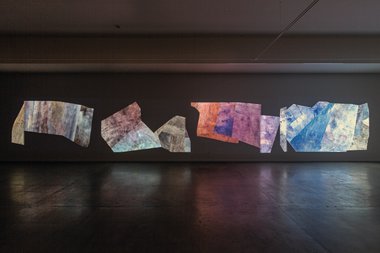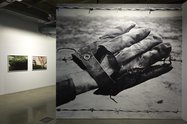John Hurrell – 19 May, 2021
In a much larger, more abstract work, 'Newspaper (for Bathers, Weekend)', we also see the moving images of butted shapes on the large horizontal wall, vertical edges silently creeping from right to left, replacing old sign systems, knowledge formats and stained colours with new. Lacey uses digital discs for this wider four projector display, tying the flatter picture plane to the changing properties of language and how the original meanings of words disintegrate, mutate, blur and absorb alongside others.
Auckland
Sonya Lacey, Fiona Amundsen, Sriwhana Spong, Mata Aho Collective and Maureen Lander
2021 Walters Prize Finalists
13 May - 5 September 2021
This year’s Walters Prize line up of finalists (delayed due to Covid) has three submissions on the top floor, and the other on the bottom one—the latter continuing its spectacular (several stories-high) presence as shown in Toi Tū, Toi Ora. It is anybody’s guess which way the judge (Kate Fowle) will lean in early August, but Mata Aho (with Lander) is probably the hot favourite, collectives being the most popular practice mode of our time for such prizes. However there is an argument that by incorporating the two Michael Parekowhai elephant bookends from Toi Tū, Toi Ora into their installation Mata Aho have subtly weakened and not strengthened their case. (More on this later.)
This year the gallery exhibition design team (in consultation with the artists) has made the floorplan much more balanced than what it was in 2018. The three top floor shows (Lacey, Spong, Amundsen: each with a variety of isolated-carefully positioned—components) lock in well together. Flowing in unison to make up a dynamic spatial sequence, it is an exciting walk for any observant body-sensitive perambulating visitor. The positioning of the visual elements and facilities for screening, is classy.
In the Amundsen presentation (A Body That Lives) you ponder over three Japanese WW2 stories—the Battle of Okinawa; the Cowra (P.O.W.) breakout and massacre; the firebombing of Tokyo—and ask how they (with four speaking eye-witness interviewees) fit together. The placement of screens and speakers only just avoids confusion if you stand where the sound is clearest and you can see the pertinent screen. There is a lot of aural overlap.
However the narrative threads of the three stories remain unentangled if you can decipher the cluster of work labels and identify the videos, while five photographs (three trees in Tokyo and Okinawa; a grim image of Tokyo in fiery ruins; and a handmade baseball glove from Cowra) accentuate key aspects. Overall though, Amundsen tries to cram too much into the space. Especially sonically.
Sonya Lacey‘s project, Weekend, focusses on the lives of the printers in London who facilitate the inky production of hardcopy weekend newspapers. While living in the UK she discovered near Fleet Street the existence of the St. Bride Foundation swimming pool (later covered over) where the tradesmen who worked the machinery could bathe in the waters of the Thames, courtesy of a Victorian philanthropic organisation. When that water was later found to be filthy and unhygienic, the pool was closed down and boarded over.
Lacey‘s installation uses a freestanding centrally positioned (steps/seating) sculpture and long inset brass wall reliefs to architecturally reference the pool with outflows at both the ‘shallow’ and ‘deep’ ends. She has photographed the London pool’s floor and collaged the images with delicately faded newspapers that have been incessantly washed and scrubbed. Only illegible traces of blurred text remain, here combined with angled tiles and grouting. In Dip, these images are projected from 16 mm film on two projectors, and in the image the advancing edge moves from left to right. Lacey here seems to be advocating the value of recreational activities like swimming, that through relaxation replenish the bodily and mental life of each worker.
The corrosive effects of time and uninterrupted labour become a conspicuous trope here, but in a much larger, more abstract work, Newspaper (for Bathers, Weekend), we also see the moving images of butted shapes on the large horizontal wall, vertical edges silently creeping from right to left, replacing old sign systems, knowledge formats and stained colours with new. Lacey uses digital discs for this wider four projector display, tying the flatter picture plane to the changing properties of language and how the original meanings of words disintegrate, mutate, blur and absorb alongside others.
Lacey’s control of her material and her use of gallery architecture is impressive, and conceptually (as a spatial information package) much tighter than her competitors. Making the gallery into a sort of abstracted swimming pool is pretty witty, and with the film projector work, the cut hole in the wall becomes a mini-pool tilted on its side, its floor serving as a screen.
Sriwhana Spong’s installation features the film (the painter-tailor) about her Balinese grandfather’s painting, that she screened in St Paul St during How to Live Together, a show that Balamohan Shingade organised in 2019. The film is now shown in an elegant white cube with three seats. Outside it, in the main gallery space, is an assortment of seven percussive instruments inspired by Balinese gamelan orchestras. These include a cast bronze table with bowls, various glockenspiel or xylophone-type creations, and gongs-and will be used in a series of musical performances presented during the Walters show, and played by women musicians representing female intellectuals Spong admires.
On the outer walls are two snake forms (inspired by her personal outdoors encounter with a serpent) made of linked cut-off coat-tails stitched onto horizontal rectangles of canvas: symbolic castration and renewed tumescence cleverly combined.
Spong‘s presentation joins the respatialised painter-tailor to part of the work she showed in AAG’s Honestly Speaking, the instruments from Now Spectral, Now Animal. The new format’s juxtaposition suggests a parallel sensibility between the turbulent and dense images of the discussed painting (where ferocious bug-eyed demons are fighting delicate dancers) and the complex music that is made during gallery performances. The film is long and meandering, but a series of pages from the painter’s photo album at the end help provide a few connections.
Mata Aho and Maureen Lander’s striking contributions (one behind the other; one unimpeded, the other cut in half by the mezzanine floor) are made of vertically descending layers of carefully cut screen door mesh combined with woven-in linear strands of muka, cotton and wool. In Atapō, two concentric diamond shaped holes are dominant motifs, the spatially diminishing lozenges facing in opposite directions.
They represent two alter egos of the same powerful atua, two linked and very powerful bodily-connected deities Hine-tītama (Goddess of Dawn) and Hine-nui-te-pō (Goddess of Death). Their presence references the transmission and protection of valuable knowledge systems that accumulate over time—and female bonding. The smaller suite of screens (with many diamonds) behind the deities seem to represent the global Māori community.
So down the other end of the huge Grey Gallery, how do we interpret the presence of the two Michael Parekowhai elephant bookends? He doesn’t have the worthy status of ‘collaborator’ like Lander, but the Mata Aho Collective wall label does point out his participation and that he references time, human perception and knowledge accumulation. His inclusion with the two part Te Ao Hurihuri is clearly deliberate. No other non-Walters Prize artists are in the space.
With one of the white elephant bookends turned on its head, that fact suggests a critique of Sir George Grey‘s library and mania for collecting, with sliding books about to metaphorically fall off the shelf. It might even be taken as a critique of non-European knowledge systems too, an overarching gesture of nihilistic epistemological despair—but also through its sheer generality of including all memory (all acquired knowledge), a clever way of allowing Mata Aho to deconstruct themselves, to undermine the existence of total certainty in any system. An unexpected withdrawal of blind confidence that might work against them. We’ll see.
John Hurrell
Recent Comments
John Hurrell
Here are some pithy conversations about these issues on FB: https://www.facebook.com/john.hurrell.16/posts/4188012374622486?comment_id=4197428720347518&reply_comment_id=4208566082567115¬if_id=1628968081139637¬if_t=feed_comment&ref=notif
John Hurrell
It is an odd statement because it is quite contradictory. She has awarded one artwork the prize in preference over ...
John Hurrell
Here is Fowle's statement within the official announcement from the gallery: Mata Aho Collective and Maureen Lander have been announced ...



 Two Rooms presents a program of residencies and projects
Two Rooms presents a program of residencies and projects Advertising in this column
Advertising in this column



This Discussion has 4 comments.
Comment
John Hurrell, 8:59 a.m. 7 August, 2021 #
Today is the day Kate Fowle announces her decision. Each of us will have their own take on the line up and who deserves the accolade of 'Winner'. Remember though, if you look back over the last twenty years and the nine winners so far, you probably only agree with the judge's decision only a few times. The winner is immaterial in that whole package of a very public event (the hoopla!) is what is valuable. Even when the jurists and the judge bungle it, the intense talk and commentary that follows is what we should be grateful for. Hopefully frenzied debate will follow (within the artworld, rather than the community outside it).
John Hurrell, 8:36 a.m. 8 August, 2021 #
Here is Fowle's statement within the official announcement from the gallery:
Mata Aho Collective and Maureen Lander have been announced tonight (Saturday 7 August) as the winner of the Walters Prize 2021, New Zealand’s most prestigious contemporary art award. The announcement was made by this year’s Walters Prize international judge, Kate Fowle, Director of New York’s MoMA PS1, at a gala dinner held at Auckland Art Gallery Toi o Tāmaki. Mata Aho Collective and Maureen Lander receive $50,000 for the honour.
Mata Aho Collective and Maureen Lander were awarded the Prize for their presentation of Atapō, 2020.
In judging the award for which there were four finalists, Fowle said, ‘The installations bring nuanced perspectives on social, cultural and political urgencies of our time that each deserve our attention and engagement. As such, it does not feel appropriate to award the prize based on a personal selection of one work over another, particularly when I cannot physically be present with them.’
‘Instead, I would like to award the Prize to Mata Aho Collective and Maureen Lander as a celebration of the inspiration they bring through their sustained collective practices, as well as for the potential futures they offer in their collaborative thinking and generative processes. For me, these qualities, together with the commitment the artists have to creating proximity, signal the work that needs to be done by all of us in the coming years, regardless of the barriers we encounter.’
Fowle made her selection from exhibited works by artists Fiona Amundsen, Sonya Lacey, Mata Aho Collective and Maureen Lander, and Sriwhana Spong.
‘The eight women that were selected by the jury and the four installations that they have produced reveal incredible sophistication in how to invite us to embrace often fluctuating or contradictory perspectives on a story or a phenomenon that is otherwise somehow out of reach. As different in form and subject as each presentation is, there is a powerful, uniting force in how they each ask us to slow down, listen, be present, think again and be aware of our environment, ourselves, our contexts,’ says Fowle.
John Hurrell, 8:41 a.m. 8 August, 2021 #
It is an odd statement because it is quite contradictory. She has awarded one artwork the prize in preference over the others. She has not spread it around all four finalists. It's confusing.
John Hurrell, 8:51 a.m. 15 August, 2021 #
Here are some pithy conversations about these issues on FB: https://www.facebook.com/john.hurrell.16/posts/4188012374622486?comment_id=4197428720347518&reply_comment_id=4208566082567115¬if_id=1628968081139637¬if_t=feed_comment&ref=notif
Participate
Register to Participate.
Sign in
Sign in to an existing account.